Just before the event, I was invited by Ali, a friend in Sumba, to experience Pasola, a day of ritualized Tribal war games for young warriors to prove their courage. It takes place in several locations in February and March each year in the western part of Sumba Island, Indonesia.
I had been in Sumba last spring for a week in 105o heat with matching humidity. We drove past the Pasola grounds where we’d just missed the event by two days. All reports were that Pasola was great and the non-natives suffered badly from the heat.
During that trip to Sumba, I too, succumbed to heat exhaustion after spending the day climbing to one hilltop village after another. Nobody wants a white boy sick or dying on their watch, so everyone was happy when a Western doctor was found and I recovered by morning. I’d had such amazing experiences that trip, I vowed to return to see Pasola and more of Sumba, an island that many consider the most primitive in all of Indonesia.

When the invitation from Ali came, I put my fate in the hands of the Gods, even though I had health concerns. If there was a round trip ticket available, I’d go. Two days later, when I arrived at the airport, I found we were on a 45 year old turbo prop. We were delayed because we were waiting for a part to be flown in from Jakarta that we would then take to Sumba to fix a disabled turbo on a nearby island. The airline’s record of canceled flights is staggering. If a flight is only a few hours late, everyone is happy. You simply don’t go if you can’t afford to lose a couple of days to delays.
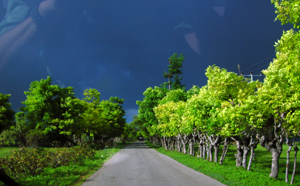 Back in Sumba! It’s the rainy season and lush, green, tropical vegetation covers the hilly back country of west Sumba. In July it will be a parched, dusty brown with little or no rain for four months. For now, the steep rocky trails to the hilltop villages are wet, moss covered, and treacherous. Thick undergrowth chokes the narrow pathways. My sport sandals help, but I wonder if the barefoot villagers are better off. Once in the village, I step over, around, and occasionally through the dung of water buffalo, chickens, dogs, horses, and pigs.
Back in Sumba! It’s the rainy season and lush, green, tropical vegetation covers the hilly back country of west Sumba. In July it will be a parched, dusty brown with little or no rain for four months. For now, the steep rocky trails to the hilltop villages are wet, moss covered, and treacherous. Thick undergrowth chokes the narrow pathways. My sport sandals help, but I wonder if the barefoot villagers are better off. Once in the village, I step over, around, and occasionally through the dung of water buffalo, chickens, dogs, horses, and pigs.
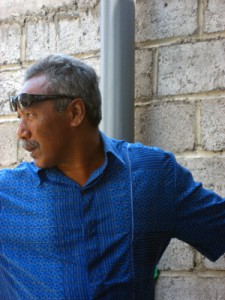
My friend Daeng, who took me on the cultural/buying trip to Sumba last year, calls the villages dirty. He is a native Sumba man who’s made it to the top of the collecting world in Indonesia while living in Bali. I guess the villages are dirty, but to me, the houses are quite aesthetically pleasing. I imagine these are typical of any tropical, primitive village; subsistence farming and livestock for food, bamboo houses with high thatched roofs, with animals living below and people above. There is a cooking fire in the center of the house, which, over time, blackens everything above the 4th level. People do their socializing, food prep, and hanging out on the long, raised, covered front decks that face the “village green.”
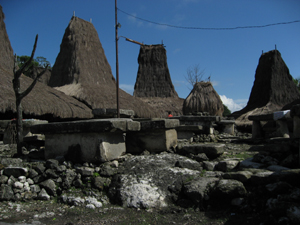
There are usually only 12 – 18 houses in a village, though there may be one or two other villages within a stone’s throw. The huge, old, stone table top grave markers, that dominate the central common area of the village, are an insistent reminder of the ancestor worship that is central to this animist culture. They are sculpturally bold and stunningly beautiful in a most primitive, powerful way. They exude energy that helps define and bond village life. Every village has the feeling of a Stonehenge. Each stone took 100’s of people months to cut, carve, move up the mountain to the village center, and lift onto four stone pillars. In the older villages, some of these stones were placed over 400 years ago.
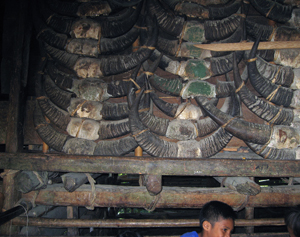
Upon entering a village, you are expected to call out to announce your arrival, ask the way to the village head’s house, pay an “entrance fee,” and sign a book. This money is set aside for village emergencies. I have often visited villages where no one has signed in for a year or more. At this time the traditional gifts of cigarettes for the men and betel nut for the elders are distributed; our hostess gifts, if you will. The villagers and I study each other, looking for differences as well as common ground. We try to imagine, discover, and perhaps connect to the other’s life. I wonder at the collections of buffalo horns that cover the walls behind the front porch of each house. Each horn is from the very animal that was at the funeral feast of the ancestor who was honored by that tribute. Those three were for great uncle Charlie and this one was for great, great grandpa Jones… Something like that. The horns are beautiful, hung in perfect vertical rows, and numbering over 100 in older or wealthier families. They wonder at the digital camera, delighting in the instant photos of themselves. They look at my shoes, white skin and blue eyes. We all smile, laugh, bow and shake hands. We sit and talk for a few minutes, and the atmosphere became relaxed and friendly. People are generally looking for a any reason to laugh, so I find something goofy to say or do to bring out a smile or a chuckle. Often, there is a momentary bond with someone, even a touch of love exchanged. This unexpected, sweet food is for my heart; the cultural and physical anthropology of the village feeds my mind; and the beauty and ancient vibrations of the stone markers and sculpture feed my soul.
I leave deeply nourished, enlivened, and happy.
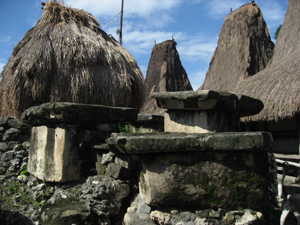
I regret having to saying good-bye, yet I do walk back down the slippery path with Ali and Ali’s friend to the AC car and our driver. We navigate the rough roads to another village, see an amazing ancient sculpture, and are treated to the sun engulfing monster thunderheads as it goes down in glory. We arrive back at the hotel after dark, only to be “greeted” by a dozen villagers and would-be traders. Ten or fifteen hands reach out to show me their wares. I want them to go away, but I see hope, prayer and some calculation for a bit of profit in their eyes. I’m surrounded, exhausted and still curious about their offerings. I know that I am their last chance tonight for “a chicken in the pot.” I can guess what else a sale can mean to them. I respect the challenge they live in, and I try somehow to touch each one, to joke with them, to simply be human. Finally, I’m just tired. They will wait until I return from dinner or will reappear in the morning.
My room is my oasis and escape. It’s big and it’s one of 9 or 10 air conditioned rooms in all of West Sumba, as far as I can tell. It offers a bucket of cold water for a bath, an Asian toilet, a sink with no running water, and a thin towel that doesn’t wrap all the way around my waist. A few minutes later, the four of us meet again to drive the 8 blocks to eat at the best restaurant within 50 km.
Formica tables, vinyl floors, plastic flowers and a sweet staff. Our dinner for four is about $13, including the meals I send home for Ali’s friend’s and four kids. Their mother left 2 years ago. No one has heard from her since. Ali’s friend and the driver are a bit shy through dinner. The fancy restaurant with a white boy is new to them. They order too little. I order enough extra so everyone’s well fed. They leave the table to smoke, even though it’s common to smoke at the dinner table. I appreciate that gesture and invite them back for desert. No takers.
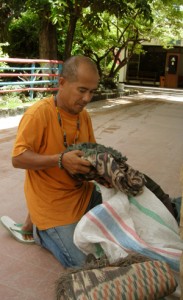
We walk back through the sellers, pausing here and there to look. I buy an old Kodi sarong of hand woven ikat with natural dyes. They drop me back at my hotel after we plan the next day, Pasola! I ask for and receive soap and toilet paper at the front desk on my way to my room. It’s not automatically provided. At the appointed hour, 4:30 am, hot tea and toast will appear at my door for breakfast. Right now, I’m dead tired and my room is close to heaven. It’s clean – on a sliding scale of “clean.” I have only to write descriptions of the things I bought today, label them, make notes of the day, and prepare for tomorrow before I sleep. I can’t believe I was in Bali this morning. It’s worlds away.
I’m happy. I bought cool pieces, saw sights that are rarely seen by white man, touched and was touched by some sweet villagers, I’m fed and watered, safe and cared for, and yes, thankful. It’s hard to express the level of peaceful gratitude I feel. What more could I ask?
My mind, heart and soul are too stimulated for good sleep. Massive thunderstorms and night traffic inform my dreams and punctuate my nighttime naps.